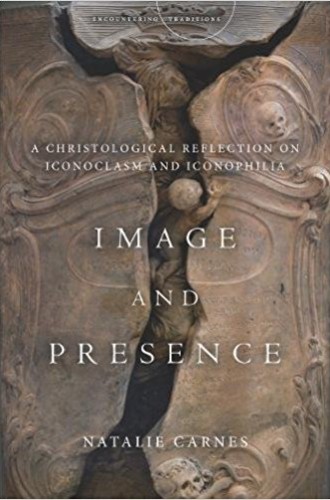When we interact with religious images—from an icon of Christ to a pixelated picture of Jesus on a computer screen, from the plastic bobble-head Jesus on the youth pastor’s desk to a famous medieval altarpiece—what do we experience? Revelation, longing, closeness to God, danger, mystery, hope, disappointment, peacefulness, fear?
Theologians have long understood that when we talk about God, we need to be aware of language’s limitations, lest we turn our theological concepts into conceptual idolatry. Our relationship to even our most cherished images needs to include critical suspicion of what those images can and cannot do.
Natalie Carnes takes the argument one step further. She says that iconoclasm (the impulse to combat an image) contains within itself the seeds of iconophilia (veneration or recognition of the image’s power). “Without iconoclasm, iconophilia risks idolatry. Without iconophilia, iconoclasm turns to despair.”
Carnes believes that all images are tinged with the negation of that which they represent. It’s this form of iconoclasm that the book primarily explores, particularly in relation to images of Christ. Carnes explains:
Images need negation to be images. The negation at the heart of imaging is not an eradication nor an erasure. Neither is it a degradation of the image. It is a breaking open that leads to greater revelation. It is a way of saying that images mediate presence-in-absence and likeness-in-unlikeness.
Carnes sees this complexity as a reflection of the paradoxes at the heart of Christology. Images, in their constant negotiation between presence and absence, reflect God’s own imaging in the material and divine Christ. As Carnes puts it, “Christ negates to reveal.”
All of this may sound theoretical—and it is. Carnes engages theologically with culture at a level much deeper than the standard fare of using ancient theologian X to solve modern problem Y. She deftly interweaves art theory, sociology, literature, and contemporary philosophy into her reflections. The result is a dialogue between theology and aesthetic theory that takes work to unpack. This book isn’t meant for a general audience. But its implications for Christian life are significant, even beyond the obvious questions about how people of faith relate to images.
If it’s true that, as Carnes writes, “Christ is the Image who limns the structure of imaging,” there are implications for faithful Christians who see themselves as creatures made in God’s image. In fact, when we view Christ (whether theologically or in material images) through the paradox of divinity and humanity—and the corresponding paradox of invisibility and visibility—our ethics will be shaped accordingly. In a chapter that discusses images of the resurrected Christ, Carnes writes:
The whole world can be perceived as an image of its divine Creator when the invisible is received through the visible. . . . By reducing the world to visibility, by circumscribing it to the domain of the visible, one submits the world to one’s own powers. Such submission is not an ascent in love; it is a subjugation for power. . . . We receive the divine by serving those who bear no obvious trace of divine glory. We see the hungry, the thirsty, the stranger, the sick, and the imprisoned, and the honor we give them redounds to Christ.
How we see Christ influences how we see the neighbor. It also shapes our sense of ourselves as made in God’s image, giving weight to our ethical sensibilities.
Carnes’s examination of the image of the crucified Christ in Matthias Grünewald’s Isenheim Altarpiece leads to questions about what it means to imitate Christ in a world that is broken by crosses of our own making. Drawing on the poetic language of John Donne and Christian Wiman, Carnes writes that the cross “is the image that gathers all others to speak to the love that is the grain of the universe—the grain that is bread broken for we who are broken, the grain that breaks our brokenness by its own brokenness, the grain that is the riven and riving presence of Christ.” The form that Christ’s love takes in brokenness, however, is far from passive:
Christ suffers rivenness in order to rive it. Christ on the cross breaks brokenness itself. The cross is God’s refusal to let violence be determinative. For, on the cross, Christ reveals God to be love all the way down. Christ shows that love is not so shallowly rooted in the universe that it can be pulled out by trial and torture. This is a love so deeply embedded in the fabric of the cosmos that even death cannot alter it.
In this way, Christ’s activity on the cross is itself a form of iconoclasm—but it’s an iconoclasm rooted in the depths of divine love.
Carnes demonstrates throughout the book that the boundaries between love of images and suspicion of images are more fluid in practice than in theory. Her theological centering of this claim in Christology holds promise for ecumenical theology. Rather than focusing on doctrinal debates over images or historic acts of violence between Orthodox, Roman Catholic, and Protestant Christians, she subtly deploys various traditions in her christological reflections. By highlighting similarities among believers long considered to be separated by their attitudes about images, she breaks down Christians’ own images of ecumenical divides.





